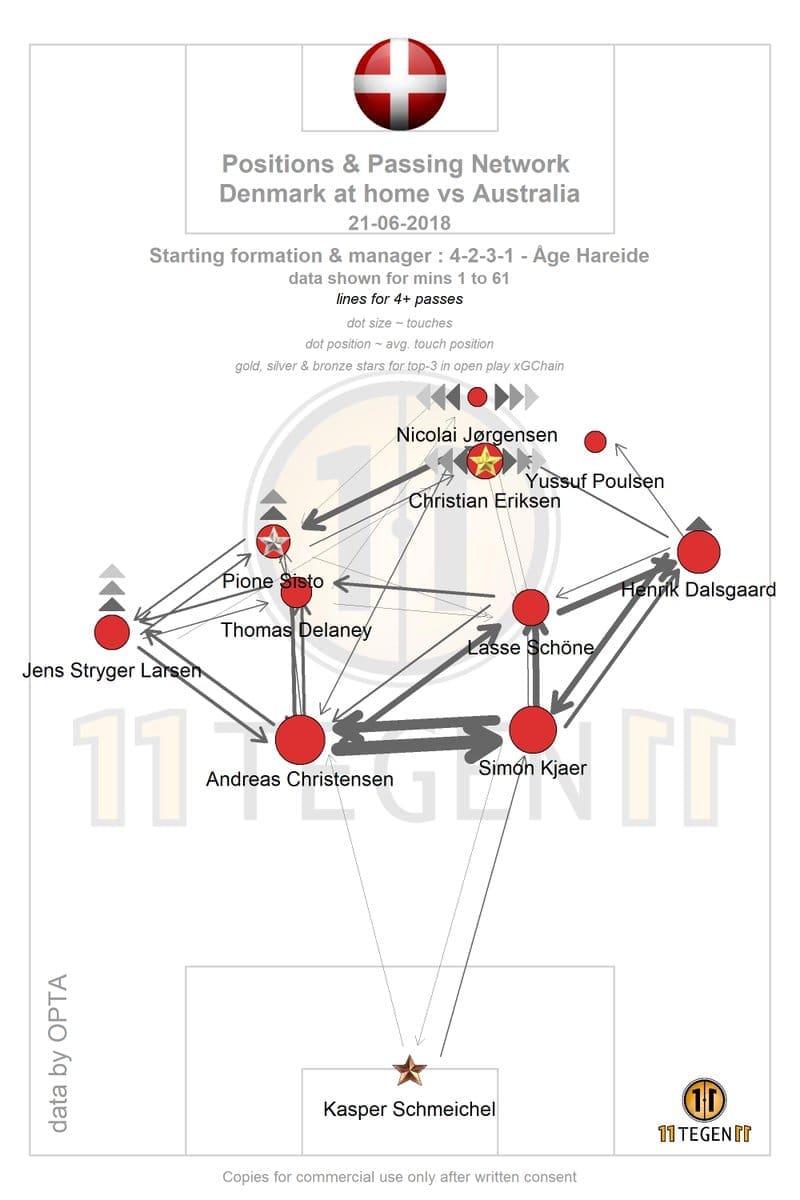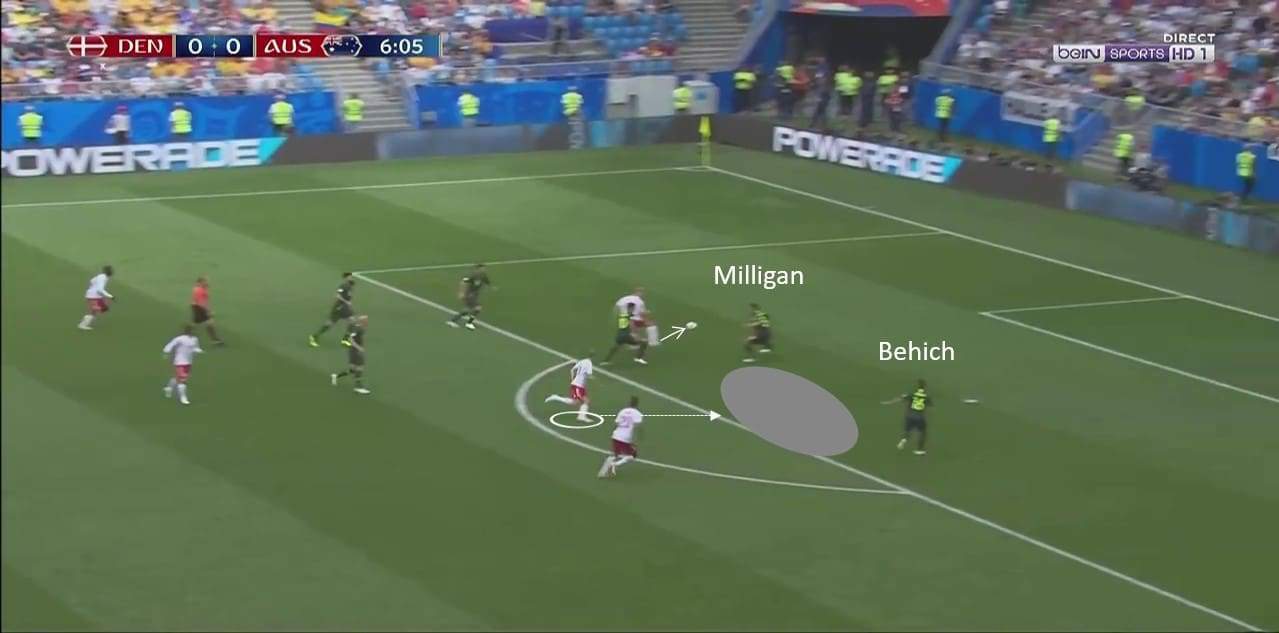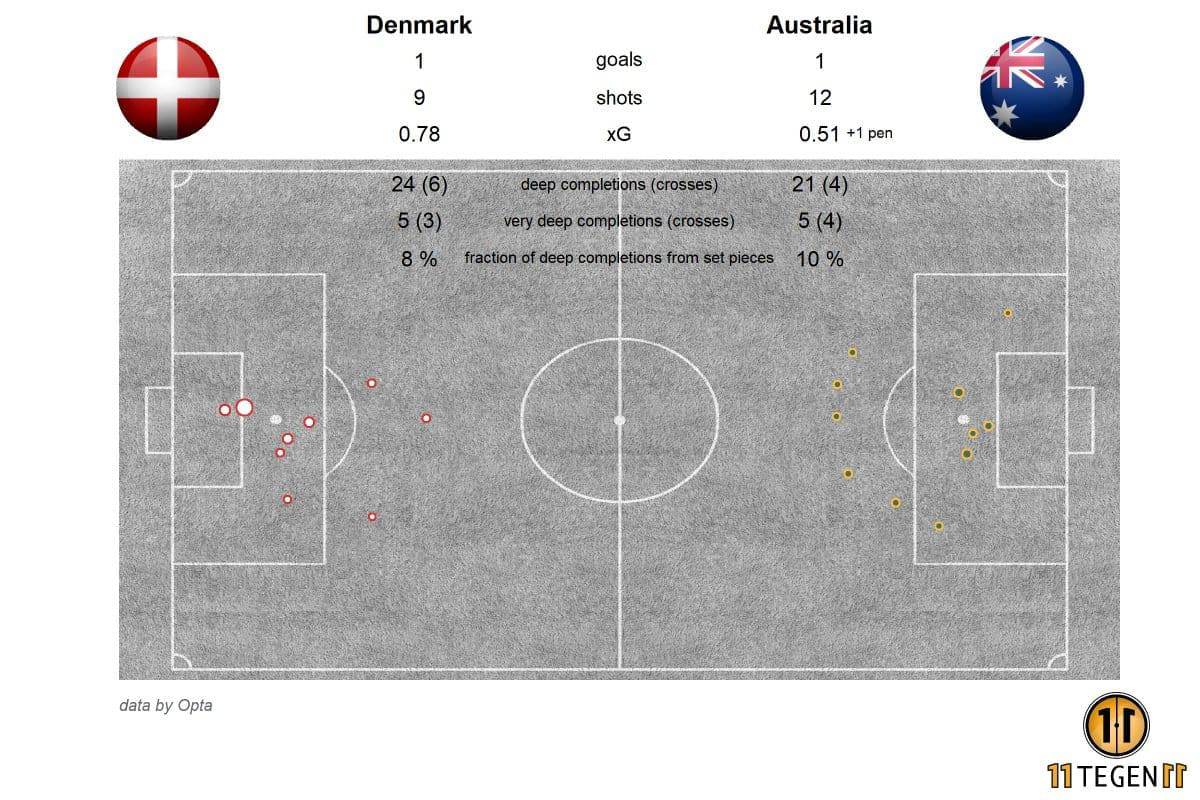A win against Australia would have been enough for Denmark to go through the round-of-16 but it wasn’t here that they progressed despite the fact that the Danes scored the opening goal after just six minutes in the match.
After the win against Peru in the opener, Denmark lined up an almost unchanged starting XI with Lasse Schone for the injured William Kvist being the only change.
Denmark controlled the game through possession at the beginning, using Nicolai Jorgensen’s movement to attack Australia’s backline. This pattern has to be considered alongside with Jens Stryger Larsen pushing higher up the field on the left flank. Larsen’s runs have been effectives and they also opened spaces exploited by Pione Sisto.
In fact, with Socceroos shifting on the wide area to contain Larsen, Australia tended to lose their horizontal compactness, leaving both Sisto and Christian Eriksen free to roam in the left half-space and in the centre. With the ball on the far side, Australian back line and midfield turned their focus on the middle and their left defending area which made Danish able to exploit Socceroos’ right defending zone through passes to Larsen, particularly through some nice, diagonal balls from right centre-back Simon Kjaer.

This game plan was nicely executed by Denmark and led to Eriksen’s goal. It happens starting from a Schone’s forward pass forward under pressure that surprised Australia. The ball goes to Jorgensen who is able to play a two-touches pass with the outside of his boot to the upcoming Eriksen. Denmark’s star player made a great half-volley shot bursting into the gap created by his mate’s movement.

It was Eriksen’s 13th goal in his last 15 appearances he made for Denmark. But this goal was much more than it. It was the epitome of Denmark’s collective approach to the game. Each player involved perfectly understood his teammates’ movements. On his part, Eriksen – Denmark’s best player – wasn’t the man charged with the expectation to sparkle outside from the context but rather a bright footballer inserted in the cohesive and tactically ready side.
However, as the game went on, Australia looked more able to deal Denmark’s high-press by fortifying their build-up. It allowed the Australians to bypass Denmark’s first line of pressure, taking advantage from a Danish stretched team. Particularly Mike Jedinak was successful in exploiting this, whilst Australia beat Denmark’s pressure. Mathew Leckie used the gap Larsen to hurt Denmark’s backline on their left side, forcing Age Hareide’s side to play deeper in their own territory. Defending in a deep-block made difficult for Denmark to attack through quick transitions. Fortunately for them, Australia’s well-knew inability to score made Danish backline work easier.

So, just a controversial VAR penalty made Socceroos able to tie the game. Then, both teams looked happy to earn a point, with Australia’s coach Bert van Marwijk that made a defensive-oriented substitution bringing on holding midfielder Jackson Irvine to replace Tom Rogic.
Conclusion
In the end, this result left Denmark in a good qualification spot as the final round results confirmed later. That said, for Danes expecting to repeat Danish-dynamite’s exploits at the 1986 World Cup in Mexico, it wasn’t a great tournament. Expectations were high and Denmark’s playstyle – a direct one without endless ball retention – looked perfect to approach this tournament. Surely, Danes progressed out from the group stages of a World Cup for the time since 2002 and they left Russia just after a penalty shutout against Croatia, but more was expected by a side featuring players such as Kjaer, Thomas Delaney, Yussuf Poulsen or the same Eriksen, a key part of Denmark’s playing style. In fact, Since Hareide took the job back in 2016, the Norwegian coach stayed away from building his side around Eriksen like it was a kind of one-man show. Instead, he inserted Tottenham’s star in a side where the 26-years old attacking midfielder can flourish following a team’s path.
Denmark confirmed some pattern as their preference to build up from the left where Larsen pushed forward while Sisto moved inside. Focus on collective movements made Denmark flexible when in possession, trying to manipulate opposite’s defensive structure to take advantage from, as it happened with Eriksen’s goal against Aussie.
However, these movements weren’t ever well-executed and contributed to making Danes unable to achieve a better result than a spot into the second round of the World Cup. Truth to be told, a third-round qualification at least was expected on the verge of the tournament.





Comments